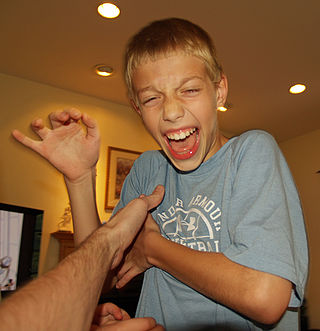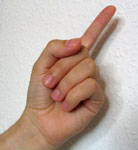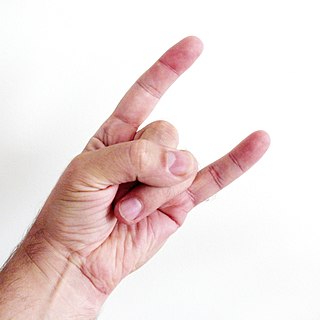A slang is a vocabulary of an informal register, common in everyday conversation but avoided in formal writing. It also often refers to the language exclusively used by the members of particular in-groups in order to establish group identity, exclude outsiders, or both. The word itself came about in the 18th century and has been defined in multiple ways since its conception, with no single technical usage in linguistics.

LOL, or lol, is an initialism for laughing out loud, and a popular element of Internet slang, which can be used to indicate amusement, irony, or double meanings. It was first used almost exclusively on Usenet, but has since become widespread in other forms of computer-mediated communication and even face-to-face communication. It is one of many initialisms for expressing bodily reactions, in particular laughter, as text, including initialisms for more emphatic expressions of laughter such as LMAO and ROFL or ROTFL.

The V sign is a hand gesture in which the index and middle fingers are raised and parted to make a V shape while the other fingers are clenched. It has various meanings, depending on the circumstances and how it is presented.
LGBTQ slang, LGBTQ speak, queer slang, or gay slang is a set of English slang lexicon used predominantly among LGBTQ+ people. It has been used in various languages since the early 20th century as a means by which members of the LGBTQ+ community identify themselves and speak in code with brevity and speed to others.

Wanker is slang for "one who wanks (masturbates)", but is most often used as a general insult. It is a pejorative term of English origin common in Britain and other parts of the English-speaking world, including Ireland, Australia and New Zealand. It is synonymous with the insult tosser.

Greeting is an act of communication in which human beings intentionally make their presence known to each other, to show attention to, and to suggest a type of relationship or social status between individuals or groups of people coming in contact with each other. Greetings are sometimes used just prior to a conversation or to greet in passing, such as on a sidewalk or trail. While greeting customs are highly culture- and situation-specific and may change within a culture depending on social status and relationship, they exist in all known human cultures. Greetings can be expressed both audibly and physically, and often involve a combination of the two. This topic excludes military and ceremonial salutes but includes rituals other than gestures. A greeting, or salutation, can also be expressed in written communications, such as letters and emails.

Haptic communication is nonverbal communication and interaction via the sense of touch. Touch can come in many different forms, some can promote physical and psychological well-being. A warm, loving touch can lead to positive outcomes while a violent touch can ultimately lead to a negative outcome. The sense of touch allows one to experience different sensations such as pleasure, pain, heat, or cold. One of the most significant aspects of touch is the ability to convey and enhance physical intimacy. The sense of touch is the fundamental component of haptic communication for interpersonal relationships. Touch can be categorized in many terms such as positive, playful, control, ritualistic, task-related or unintentional. It can be both sexual, and platonic. Striking, pushing, pulling, pinching, kicking, strangling and hand-to-hand fighting are forms of touch in the context of physical abuse.

The high five is a hand gesture whereby two people simultaneously raise one hand and slap the flat of their palm against the other. The gesture is often preceded verbally by a phrase like "Give me five", "High five", or "Up top". Its meaning varies with the context of use but can include as a greeting, congratulations, or celebration.

The shaka sign, sometimes known as "hang loose" is a gesture with friendly intent often associated with Hawaii and surf culture. It consists of extending the thumb and smallest finger while holding the three middle fingers curled, and gesturing in salutation while presenting the front or back of the hand; the wrist may be rotated back and forth for emphasis. The shaka sign is similar to the letter Y in the American manual alphabet in American Sign Language or the sign for number six in the Chinese hand counting symbol. The shaka sign should not be confused with the sign of the horns, where the index and pinky fingers are extended and the thumb holds down the middle two fingers.

Chinese number gestures are a method to signify the natural numbers one through ten using one hand. This method may have been developed to bridge the many varieties of Chinese—for example, the numbers 4 and 10 are hard to distinguish in some dialects. Some suggest that it was also used by business people during bargaining when they wish for more privacy in a public place. These gestures are fully integrated into Chinese Sign Language.

The OK gesture, OK sign or ring gesture is a gesture performed by joining the thumb and index finger in a circle, and holding the other fingers straight or relaxed away from the palm. Commonly used by scuba divers, it signifies "I am OK" or "Are you OK?" when underwater. In most English-speaking countries it denotes approval, agreement, and that all is well or "okay". In other contexts or cultures, similar gestures may have different meanings including those that are negative, offensive, financial, numerical, devotional, political, or purely linguistic.

The sign of the horns is a hand gesture with a variety of meanings and uses in various cultures. It is formed by extending the index and little fingers while holding the middle and ring fingers down with the thumb.

A thumb signal, usually described as a thumbs-up or thumbs-down, is a common hand gesture achieved by a closed fist held with the thumb extended upward or downward, respectively. The thumbs-up gesture is associated with positivity, approval, achievement, satisfaction and solidarity, while the thumbs-down gesture is associated with concern, disapproval, dissatisfaction, rejection and failure.

Finger-counting, also known as dactylonomy, is the act of counting using one's fingers. There are multiple different systems used across time and between cultures, though many of these have seen a decline in use because of the spread of Arabic numerals.

A facepalm is the physical gesture of placing one's hand across one's face, lowering one's face into one's hand or hands or covering or closing one's eyes. The gesture is often exaggerated by giving the motion more force and making a slapping noise when the hand comes in contact with the face. The gesture is found in many cultures as a display of frustration, disappointment, exasperation, embarrassment, horror, shock, surprise, exhaustion, sarcasm, shame, or incredulous disbelief.

Small talk is an informal type of discourse that does not cover any functional topics of conversation or any transactions that need to be addressed. In essence, it is polite and standard conversation about unimportant things.

The low five is a hand gesture when two people slap palms together. One party extends an open palm, face upward at about waist level, the other party strikes the palm in a downward swing with their open palm. It is sometimes known as "slapping five", "give me five", or "giving/slapping skin". Archaic terms for it include "slip-slapping", "slapping the plank" and "soul shake".

Pointing is a gesture specifying a direction from a person's body, usually indicating a location, person, event, thing or idea. It typically is formed by extending the arm, hand, and index finger, although it may be functionally similar to other hand gestures. Types of pointing may be subdivided according to the intention of the person, as well as by the linguistic function it serves.
















